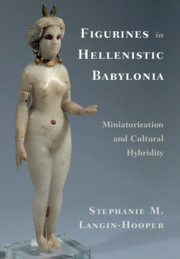52 results
Relation Between Swelling, Surface Area and b Dimension of Na-Montmorillonites
-
- Journal:
- Clays and Clay Minerals / Volume 26 / Issue 5 / October 1978
- Published online by Cambridge University Press:
- 01 July 2024, pp. 345-351
-
- Article
- Export citation
High Surface Area Solids Obtained by Reaction of Montmorillonite with Zirconyl Chloride
-
- Journal:
- Clays and Clay Minerals / Volume 27 / Issue 2 / April 1979
- Published online by Cambridge University Press:
- 01 July 2024, pp. 119-124
-
- Article
- Export citation
Adsorption of N2, O2, CO2 and H2 on Hydrotalcite-Like System: Mg2+-Al3+-(Fe(CN)6)4−
-
- Journal:
- Clays and Clay Minerals / Volume 26 / Issue 6 / December 1978
- Published online by Cambridge University Press:
- 01 July 2024, pp. 441-447
-
- Article
- Export citation
Components of Surface Free Energy of Some Clay Minerals
-
- Journal:
- Clays and Clay Minerals / Volume 36 / Issue 3 / June 1988
- Published online by Cambridge University Press:
- 02 April 2024, pp. 243-248
-
- Article
- Export citation
Determination of Surface Free Energy of Kaolinite
-
- Journal:
- Clays and Clay Minerals / Volume 36 / Issue 5 / October 1988
- Published online by Cambridge University Press:
- 02 April 2024, pp. 455-461
-
- Article
- Export citation
Molecular-Scale Imaging of Clay Mineral Surfaces with the Atomic Force Microscope
-
- Journal:
- Clays and Clay Minerals / Volume 38 / Issue 4 / August 1990
- Published online by Cambridge University Press:
- 02 April 2024, pp. 337-342
-
- Article
- Export citation
Mössbauer Effect Studies of Iron in Kaolin. II. Surface Iron
-
- Journal:
- Clays and Clay Minerals / Volume 31 / Issue 4 / August 1983
- Published online by Cambridge University Press:
- 02 April 2024, pp. 293-298
-
- Article
- Export citation
Application of Inverse Gas Chromatography to the Study of the Surface Properties of Slates
-
- Journal:
- Clays and Clay Minerals / Volume 45 / Issue 5 / October 1997
- Published online by Cambridge University Press:
- 28 February 2024, pp. 670-680
-
- Article
- Export citation
Crystal Chemistry and Surface Configurations of Two Iron-Bearing Trioctahedral Mica-1M Polytypes
-
- Journal:
- Clays and Clay Minerals / Volume 62 / Issue 4 / August 2014
- Published online by Cambridge University Press:
- 01 January 2024, pp. 243-252
-
- Article
- Export citation
On stable commutator length of non-filling curves in surfaces
-
- Journal:
- Proceedings of the Royal Society of Edinburgh. Section A: Mathematics , First View
- Published online by Cambridge University Press:
- 14 December 2023, pp. 1-18
-
- Article
-
- You have access
- Open access
- HTML
- Export citation
Chapter 14 - Poetry
- from Part II - The Literary Works
-
-
- Book:
- W. G. Sebald in Context
- Published online:
- 24 August 2023
- Print publication:
- 07 September 2023, pp 119-126
-
- Chapter
- Export citation
Bacterial colonisation of surface and core of palatine tonsils among Tanzanian children with recurrent chronic tonsillitis and obstructive sleep apnoea who underwent (adeno)tonsillectomy
-
- Journal:
- The Journal of Laryngology & Otology / Volume 138 / Issue 1 / January 2024
- Published online by Cambridge University Press:
- 19 June 2023, pp. 89-92
- Print publication:
- January 2024
-
- Article
-
- You have access
- Open access
- HTML
- Export citation
Subgraph densities in a surface
- Part of
-
- Journal:
- Combinatorics, Probability and Computing / Volume 31 / Issue 5 / September 2022
- Published online by Cambridge University Press:
- 11 January 2022, pp. 812-839
-
- Article
- Export citation
More than a century of direct glacier mass-balance observations on Claridenfirn, Switzerland
-
- Journal:
- Journal of Glaciology / Volume 67 / Issue 264 / August 2021
- Published online by Cambridge University Press:
- 11 March 2021, pp. 697-713
-
- Article
-
- You have access
- Open access
- HTML
- Export citation
Chapter 6 - A Duplication of Consciousness: Realism, Modernism and Prosthetic Self-Fashioning
- from Part IV - The Modernist Body: From James to Beckett
-
- Book:
- The Prosthetic Imagination
- Published online:
- 18 September 2020
- Print publication:
- 03 September 2020, pp 225-257
-
- Chapter
- Export citation
Global geometry on moduli of local systems for surfaces with boundary
- Part of
-
- Journal:
- Compositio Mathematica / Volume 156 / Issue 8 / August 2020
- Published online by Cambridge University Press:
- 01 October 2020, pp. 1517-1559
- Print publication:
- August 2020
-
- Article
- Export citation
Conclusion
-
- Book:
- Mimicry and Display in Victorian Literary Culture
- Published online:
- 16 May 2020
- Print publication:
- 11 June 2020, pp 205-214
-
- Chapter
- Export citation
Chapter Five - Wave–Body Interactions
-
- Book:
- Ocean Waves and Oscillating Systems
- Published online:
- 12 May 2020
- Print publication:
- 28 May 2020, pp 121-203
-
- Chapter
- Export citation
11 - Thermodynamics and Phase Transitions at Surfaces
- from Part III - Types of Phase Transformations
-
- Book:
- Phase Transitions in Materials
- Published online:
- 24 April 2020
- Print publication:
- 14 May 2020, pp 289-317
-
- Chapter
- Export citation

Figurines in Hellenistic Babylonia
- Miniaturization and Cultural Hybridity
-
- Published online:
- 19 December 2019
- Print publication:
- 12 March 2020
















